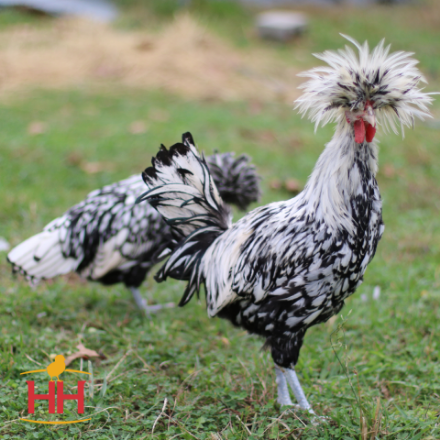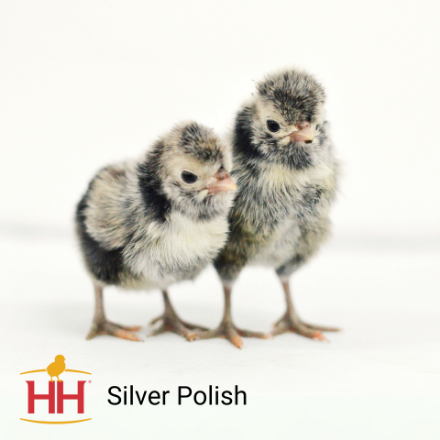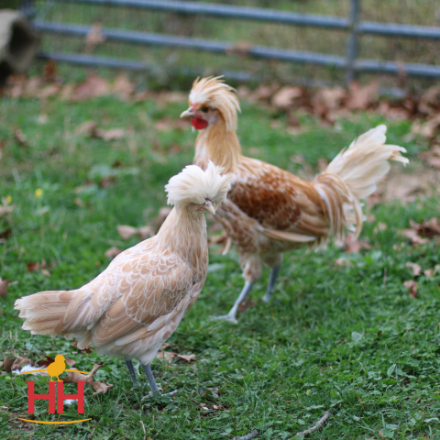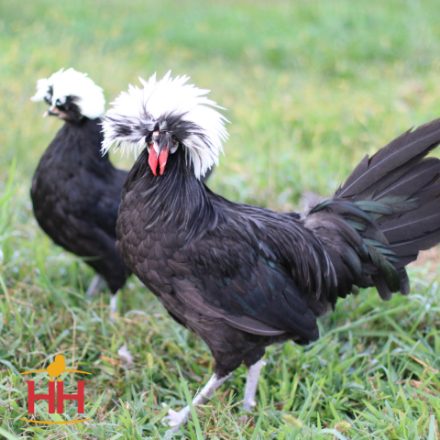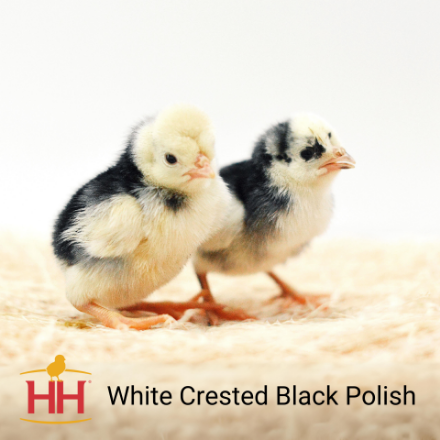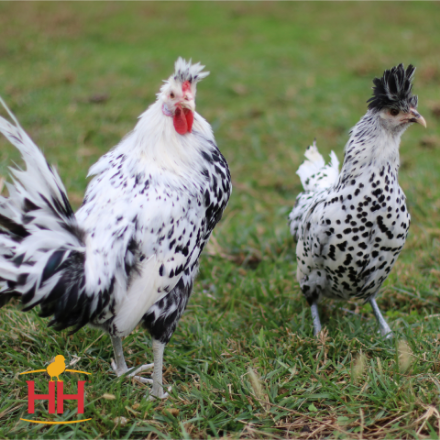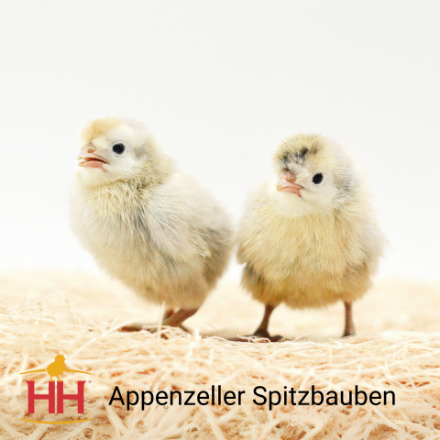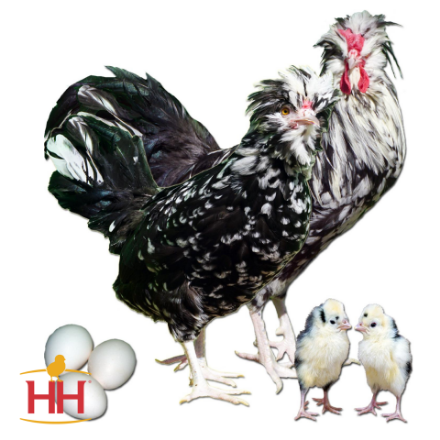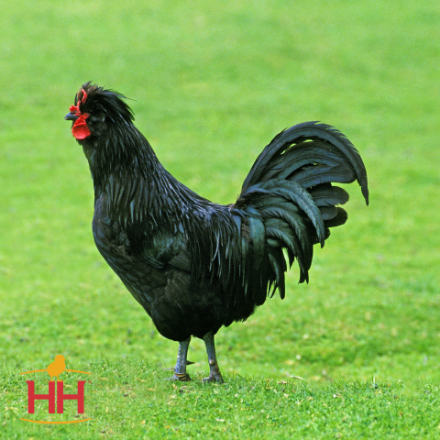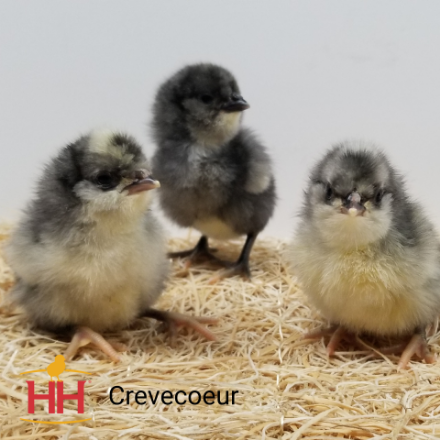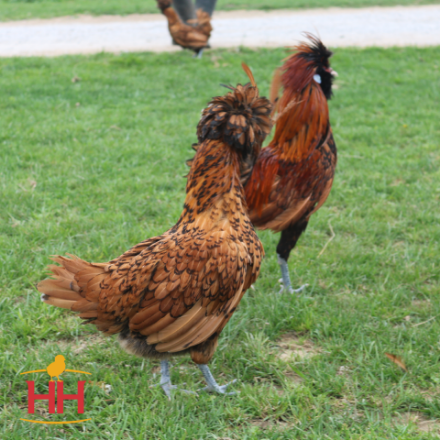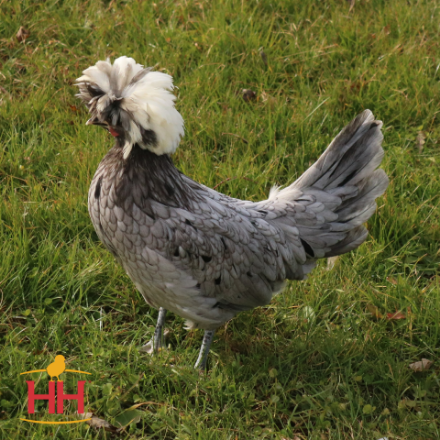Polish & Crested
Our minimum shipping quantity for chicks is 15. There is a minimum of 5 per sex and breed. We reserve the right to change order minimums as needed.
The breed is named for the Polish army's feathered caps because it resembled their feathered crests. The chickens originated in Spain and then brought to Holland, where the Dutch perfected their coloring. They became a popular bird in France, then started appearing in the U.S. around the 1830s. They are a great breed, very docile. and even-tempered. They are easily surprised due to their feathers limiting their eyesight, making them vulnerable to predators. Purpose: Ornamental Production: 100 Small White Eggs/Year Temperament: Gentle, Active Mature Weight: 4-5 lbs. Hardiness: Heat Hardy But Not Cold Hardy Broodiness: Rarely Comb Type: V Comb
Currently Unavailable
The Polish breed is named for the Polish army's feathered caps because they resembled their feathered crests. The chickens originated in Spain and then brought to Holland, where the Dutch perfected their coloring. They became a popular bird in France, then started appearing in the U.S. around the 1830s. They are a great breed, very docile, and even tempered. They are easily surprised due to their feathers limiting their eyesight, making them vulnerable to predators. Purpose: Ornamental Production: 100 Small White Eggs/Year Temperament: Gentle, Active Mature Weight: 4-5 lbs. Hardiness: Heat Hardy But Not Cold Hardy Broodiness: Rarely Comb Type: V comb
Currently Unavailable
The White Crested was a very popular breed in the late 1600's and was featured in many paintings by various artists. They are a wonderful, dual-purpose bird that also makes a great show bird. The breed tends to be nervous but lays a decent number of eggs. Purpose: Ornamental Production: 100 Small White Eggs/Year Temperament: Gentle, Active Mature Weight: 4-5 lbs. Hardiness: Heat Hardy But Not Cold Hardy Broodiness: Rarely Comb Type: V Comb
Starting at: $5.35
The Appenzeller Spitzhauben originated in Switzerland. They are black and white speckled with a V-shaped comb. These birds are excellent climbers and love to roost in trees. They do not do well in smaller coops and are free-range birds. The hens will lay medium white eggs. Interestingly, Spitzhauben is German for pointed hoods. Purpose: Ornamental Production: 155 Medium White Eggs/Year Temperament: Active, Alert Mature Weight: 4-5 lbs. Hardiness: Cold and Heat Hardy Broodiness: Rarely Comb Type: V Comb
Starting at: $5.35
Mottled Houdans are a distinctive crested variety that have five toes on each foot. They have a mottled, or spotted appearance. They are compact and have low body carriage compared to polish. Hens may be expected to weigh about 6 pounds when mature and will economically produce medium white eggs.
Starting at: $5.35
A mixture of all our Crested breeds, this assortment is based on availability and may include the Buff Laced Polish, Crevecoeur, Silver Laced Polish, Gold Laced Polish, Spitzhauben, White Crested Blue Polish and/or the White Crested Black Polish. Purpose: Ornamental Production: 100-155 Small to Medium White Eggs/Year Temperament: Gentle, Active Mature Weight: 4-5 lbs. Hardiness: Heat Hardy But Not Cold Hardy Broodiness: Rarely Comb Type: V Comb
Starting at: $5.07
The Crevecoeur is an old French breed that was once highly prized for the quality of its meat. Today it is considered a dual-purpose bird laying a fair number of white eggs while producing a moderate amount of meat. The breed was first introduced to the United States in late 1860’s but has always been a rarity. Crevecoeurs have a large globular crest on the top of their head and a small V-shaped comb that is mostly hidden by crest feathers. They are also bearded with small, virtually non-existent wattles. At first glance they seem similar to the Polish breed. However, Crevecoeurs are heavier and with blockier bodies than Polish. Purpose: Dual- Purpose Production: 200 Large White Eggs/Year Temperament: Docile, Calm, Active Mature Weight: 6-8 Lbs. Hardiness: Cold and Heat Hardy Broodiness: Occassionally Comb Type: V-Comb
Starting at: $5.35
The Polish breed was named for the Polish army's feathered caps because it resembled their feathered crests. They originated in Spain and were brought to Holland where the Dutch perfected their coloring. They became popular in France, then started appearing in the U.S. around the 1830s. A great breed, very docile and even tempered. They are easily surprised due to their feathers limiting their eyesight, making them vulnerable to predators. Purpose: Ornamental Production: 100 Small White Eggs/Year Temperament: Gentle, Active Mature Weight: 4-5 lbs. Hardiness: Heat Hardy But Not Cold Hardy Broodiness: Rarely Comb Type: V Comb
Currently Unavailable
Contrary to belief, this breed did not orginate in Poland. They were named after the Polish army’s feathered caps because it closely resembled their feathered crests. The chickens originated in Spain but were then brought to Holland, and eventually the Dutch perfected their coloring. They became a popular bird in France, then started appearing in the U.S. around the 1830s and 40s. They are a great breed and are docile and even-tempered. They are easily surprised and sometimes nervous due to their feathers limiting their eyesight. This makes them more vulnerable to predators. Blue coloring can result in black, blue, or splash feathering, blue is not a guaranteed color. Purpose: Ornamental Production: 100 Small White Eggs/Year Temperament: Gentle, Active Mature Weight: 4-5 lbs. Hardiness: Heat Hardy But Not Cold Hardy Broodiness: Rarely Comb Type: V Comb
Currently Unavailable

